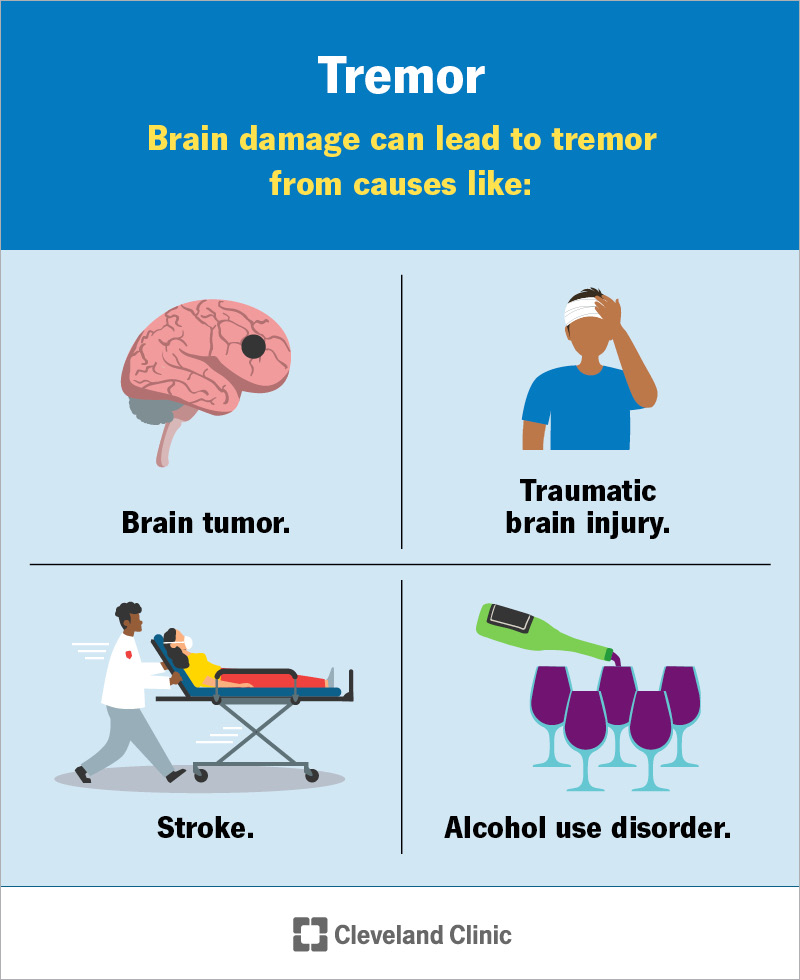Tremor is a type of body movement that’s out of your control. It looks like shakiness and can affect many different body parts. There are several types and causes of tremor. The only way to know the cause is to see a healthcare provider for testing.
Advertisement
Cleveland Clinic is a non-profit academic medical center. Advertising on our site helps support our mission. We do not endorse non-Cleveland Clinic products or services. Policy
Tremor is a rhythmic movement of a body part that’s out of your control (involuntary). The movements look like trembling or shakiness and can range from mild to severe. They may be constant or only happen sometimes. Tremor is a common symptom of movement disorders.
Advertisement
Cleveland Clinic is a non-profit academic medical center. Advertising on our site helps support our mission. We do not endorse non-Cleveland Clinic products or services. Policy
You can have tremor in one part of your body or multiple parts. It most commonly affects your hands. But it can also occur in your:
Most people naturally have a slight tremor called a physiologic tremor. You may notice that if you hold your hands or arms out in front of you, they’re not completely still. This is normal and expected. This natural tremor is typically slightly greater when you consume caffeine or alcohol, take certain medications, or are tired or anxious. Aging also tends to make this tremor worse.
Tremor is significant as a medical symptom when it affects your daily activities, like your ability to eat food, walk, dress or work. Some conditions — like essential tremor — only have tremor as a symptom. In other conditions (like Parkinson’s disease and multiple sclerosis), tremor can be one of many symptoms (or features) of them.
Healthcare providers categorize tremor into two main types based on when and how it starts:
Advertisement
Subtypes of action tremors include:

Tremor can have several possible causes, depending on the type and tremor syndrome, including:
Several medications can cause or worsen tremor. Some examples include:
If you develop tremor — or an existing tremor gets worse — after starting a medication, tell your healthcare provider.
To diagnose tremor, your healthcare provider will do a physical exam and ask questions about your symptoms and medical history. They’ll ask you:
Your provider will also do a neurological exam. This assesses your neurological functions in general, like your balance, cognition and reflexes. Your provider can also learn more about the characteristics of the tremor with this exam.
Because there are so many forms of tremor, it can be difficult for providers to determine the specific type and cause without further testing. Your provider may recommend several tests to find the underlying cause, like:
Healthcare providers define and diagnose tremor syndromes based on the pattern of the tremor. Some of the most common forms of tremor include:
Advertisement
Advertisement
The treatment for tremor depends largely on the type and the underlying cause. Tremor that results from brain damage generally isn’t curable. But tremor that happens due to medications, substances or metabolic conditions typically is.
In general, treatments include:
Advertisement
If a certain medication or substance (like caffeine or alcohol) is causing or worsening a tremor, stopping the medication (under your healthcare provider’s direction) or substance will likely help your symptoms. Similarly, treatment for metabolic conditions that can cause tremor, like hyperthyroidism, typically makes the tremor go away.
It’s also important to see a mental health specialist (like a psychologist) if tremor is causing you mental distress, like depression, anxiety or social isolation.
Aside from getting medical treatment, other steps you can take at home that may make it easier to live with tremor include:
See your healthcare provider if:
If you have a tremor diagnosis, you’ll likely need to see your provider regularly to make sure your treatment plan is working well.
Nobody likes to feel out of control of their body, so developing tremor can be concerning. There’s no way to know what’s causing tremor without seeing a healthcare provider, as there are several possible underlying causes. A provider can recommend tests to find the cause and then offer a tailored treatment plan. Tremor is — by definition — a movement that’s out of your control. But there are actions you can take to manage the underlying condition and take back some control.
Essential tremor can affect your daily life. At Cleveland Clinic, our specialists craft treatment plans to help you do the activities you enjoy more easily.

Last reviewed on 07/29/2024.
Learn more about the Health Library and our editorial process.